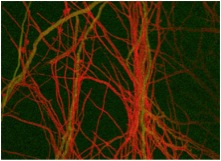
Trichodermaatroviride (red) growing along the hyphae of a host fungus (green).
(Photo by VerenaSeidl, TU Vienna and Nick Read, Univ. of Edinburgh)
Trichodermaatroviride and T. virens are filamentous fungi commonly found in the soil and are good at protecting crops such as beans, tomatoes, strawberries and cotton against a range of fungal pathogens. Their ability to do so could offer bioenergy crop growers an alternative to chemical pesticide treatment. Both were selected for sequencing by the DOE JGI, and their improved assemblies were released in 2010.
In a study provisionally released online April 18, 2011 in Genome Biology, a team of fungal researchers including DOE JGI Fungal Genomics head Igor Grigoriev and Scott Baker at PNNL compared the genomes of these two mycoparasitic fungi – in which one fungus is a parasite on the other – with the genome of another Trichoderma species sequenced at and previously reported by the DOE JGI. Unlike the other two species, however, industry relies on the enzymes produced by T. reesei for several processes, including cellulose degradation. T. atroviride had a 36.1 million base pair genome while T. virens had a 38.8 Mbp genome, both slightly larger than the 34 Mbp genome of T. reesei.
Grigoriev noted that this report is the first analysis ofbiocontrol fungi.Additionally, he said, comparing the three Trichoderma species allows researchers to study the evolution of the T. reesei. The team identified several genes across the species that are similar to each other, but also found nearly 600 genes in the mycoparasitic fungi that were not orthologous in T. reesei, suggesting that the latter has evolved from a wood-decaying, mycoparasitic ancestor that thrived on cellulose as an alternative carbon source) and lost mycoparasitic capacities.